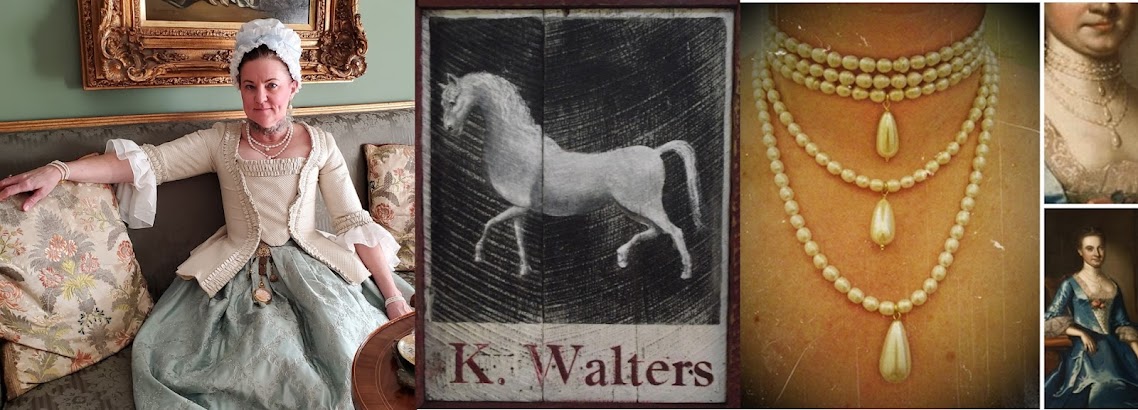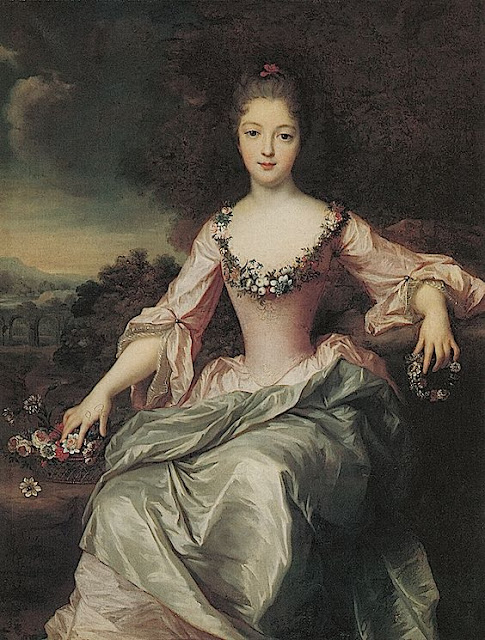Necklaces Through Portraiture and Their Popularity - Part 2
by Kimberly K. Walters
We transition from part 1 of my blog post in
February. This part focuses on the 18th century. There were a lot of changes and
discoveries taking place in the new and old worlds that included the
relationships between countries and their people. What happened politically
affected almost every aspect of people's lives, which included trade, imports, and
exports.
In my studies, I have learned that necklaces were often fastened with ribbon or clasps (what they called "lockets"). These lockets were boxed to allow the entry of a spring catch, and were made in various shapes (oval, round, heart, etc.)—usually in gold, although silver is also seen. The lockets often had holes drilled through for the fastening of chains or beads, or rings soldered to them for the same purpose. Beads were often threaded and sewn to the ribbon ends. The necklaces that I make with rings on the ends are an alternative that allows someone to just change out a ribbon versus owning multiple strands of pearls with different colored ribbon ends.
So, what was in fashion? New trends in necklaces in the
early part of the 18th century seem to have been few and far between. I'm not
saying they weren't worn, but the portraits I have come across from around 1700
to the 1740s either show just pearls, ribbon/lace, or nothing on the subjects'
necks. This could be due to a couple of reasons. The first is that I'm not
seeing all portraits, and the second is that many I have seen show the women in
"fantasy" gowns (dressed from the artists' imaginations, or using a
template they brought with them—often with a classical or historical theme—that
simply required the addition of the sitter's face and other features).
As fashions in dress
evolved, so, too, did fashions in jewelry. I have always heard and read that
fashions emerged from the whims and fancies of the monarchy and the gentry
classes, with the middling and lower classes copying the looks.
Diamond mines discovered in Brazil in 1725 replaced
India as a source for this most eternal of gemstones, and their availability
increased. Jewels set with pastes (stones made of a hard lead glass cut to
resemble diamonds) were also very sought after and their novelty enabled
experiments with cutting that were not yet tried with diamonds.
Towards the end of the
century, diamonds and gold were less popular than semi-precious and precious
gemstones due to their cost, and alternative materials were being introduced such
as the paste as we mentioned, rock crystal, pinchbeck, faux gold, etc.
There were also new dictates in fashion, and
these will be our focus when it comes to necklaces of this period. While I love
to look at original pieces, many have been reset, reconfigured, and altered so they
are no longer in their original state. Fortunately, while the configuration,
clasp, or chain may have been replaced, the "bones," as I call them,
truly show the details we need.
In my studies, I have learned that necklaces were often fastened with ribbon or clasps (what they called "lockets"). These lockets were boxed to allow the entry of a spring catch, and were made in various shapes (oval, round, heart, etc.)—usually in gold, although silver is also seen. The lockets often had holes drilled through for the fastening of chains or beads, or rings soldered to them for the same purpose. Beads were often threaded and sewn to the ribbon ends. The necklaces that I make with rings on the ends are an alternative that allows someone to just change out a ribbon versus owning multiple strands of pearls with different colored ribbon ends.
Mrs. Joseph Mann by John Singleton Copley, 1753, Metropolitan Museum of Art
Detail from Portrait of a Woman, 1745, by Johann Ulrich Schellenberg, Wikimedia
That leads me to wonder whether the jewelry in these portraits are
"fantasy" as well? The focus seems to be on the clothing and
hair. There are lots of flowers or jewels adorning the hair and clothing—possibly
remnants from the 17th century—and pearls hang from the ears, but not much is
seen around the neck. I wish it were all real!!!
Lady in a Lavender Dress by Michael Dahl, ca. 1700-1710
Wrapping gown with no jewelry
Marie Anne de Bourbon Condé by Gustaf Lundberg, 1720
No necklace, possible fantasy gown - I want her waist
The styles of necklaces range from the bib, choker, collar and swag to the festoon, fretwork patterns and bolo, just to name a few. These styles go in and out of fashion as each decade passes. I hope that everyday women wore what they loved, not just what the fashion of the decade tended to be; or that they wore pieces of jewelry that were gifted to them from family, and were therefore sentimental.
Miniature portraits also
hung from ribbon. The colors of gold and white became a very popular
combination towards the last quarter of the century, and gold jewelry
embellished with pearls was especially in vogue.
Formal 18th century jewelry was often made into parures (or sets) that had their own special boxes. A parure could consist of up to 16 matching pieces of jewelry, which included the necklace. A demi-parure may have had two or three pieces, of which the necklace was a critical part.
So let's go ahead and examine some portraits from the beginning of the century to the end. I have annotated a comment underneath each portrait to describe what I think we are seeing. You are welcome to e-mail me if you see something that I do not, or if you have original examples that can tie to a portrait.
Elisabeth Farnese by Melendez, 1718-22
Pearl collar necklace with jeweled pendant
A painting of two girls from around 1720-30, (Source unknown)
Ribbon necklaces
Anna Elisabeth von der Shulenburg-Beetzendorf, Antoine Pesne, 1730
Pearl necklace with pearl bow pendant and ribbon tie
Maria Theresa, Archduchess of Habsburg by Rosalba Carriera, 1730, Google Art Project
No necklace - diamond decoration on the gown stomacher
No necklace - diamond decoration on the gown stomacher
Frances Arnold by William Hogarth, 1738-1740 (Courtesy of BBC)
Pearl choker with ribbon tie
Magdalena Douw (Mrs. Harme), by John Heaton, 1740, Wintertur
Intricate pearl choker
Miss Mary Edwards by William Hogarth, 1742, The Frick Collection
Pearl choker with diamond stomacher style pendant
Source Unknown
María del Carmen Cortés y Cartavio, Peru, circa 1750, Denver Art Museum
Three strand pearl collar with what looks like a cut steel or diamond cross
18th century table cut diamond cross pendant, Iberian c.1710, S.J. Phillips
Henrietta Diana, Dowager Countess of Stafford, Allan Ramsay, 1759, Glasgow Museums
Ooohhhh - Fur choker
Portrait of a Lady by a student of Alexander Roslin, circa 1760
Possibly multiple strands of garnets
Portrait of a Lady by Thomas Frye, Courtauld Gallery, 1761
Glorious pearls in a bib necklace with pendant and ribbon tie
Mrs. Andrew Lindington by Joseph Wright of Derby, c.1761-2
Pearl choker and bib necklace with a pendant drop AND ribbon necklace combination with a ribbon tie
Anne
Fairchild Bowler (Mrs. Metcalf Bowler) by John Singleton
Copley, ca. 1763, National Gallery of Art, Washington, D.C.
Lovely
sapphire collet choker with cluster pendant drop
An 18th
century paste necklace with oval mixed-cut “aquamarine” colored pastes
suspending a central pear shaped and circular paste four stone drop, to a
velvet fastener, in gilt metal mounts with colored foil backs
Courtesy of Christies
Mrs. Barnard Elliott Jr. (Mary Elizabeth Bellinger) by Jeremiah Theus, 1767, Wikimedia Commons
Garnet choker with pendant drop in a bow and teardrop shape
Garnets were very popular, even Martha Washington had a gorgeous garnet necklace
A Queen
Anne original garnet necklace, circa 1770, densely set with faceted and
rose-foiled almandine garnets, in a gilt metal setting. The necklace has a
detachable pendaloque drop and tapers to ribbon fittings at either end.
Courtesy
of Rowan and Rowan
Maria Josepha of Austria, Anton Raphael Mengs, 1767, Wikimedia Commons
Silk Ribbon and bow with ribbon tie
Detail of Queen Charlotte by Nathaniel Dance-Holland 1769, Wikimedia Commons
Pearl bib necklace with pearl teardrop pendants with ribbon tie
Detail of Maria Josepha of Austria, Anton Raphael Mengs, 1767, Wikimedia Commons
Combination lace, pearls, and diamond or paste choker with ribbon tie
Mrs Bedingfield and Her Daughter by Thomas Gainsborough, 1760-1770, Wikimedia Commons
Black ribbon choker with pearl ovals and ribbon tie
Mrs Gavin Lawson by John Hesselius, 1770 Dewitt Wallace Museum
Pearl bib necklace in multiple strands
Dorothea Maria Lienau by Jens Juel , 1772, Wikimedia Commons
Single strand of pink pearls with ribbon tie
Mrs John Dart by Jeremiah Theus, circa 1772-74, Metropolitian Museum of Art
Multiple strand necklace, possible fantasy gown
Sophie Friederike, Sammlung Christian Ludwig, Herzog zu Mecklenburg, by Georg David Matthieu, circa 1774, Wikimedia Commons
Double strand collet necklace in a swag or bib
I have seen collet necklaces as fairly early in portraiture for the 18th century
Unknown Lady (Possibly Mrs. Fitzhugh Green) by John Durant circa 1768-1770, Wikimedia Commons
Collet neckace, lace and teardrop pendant and possible knotted ribbon necklace with miniature in a heart pendant
Lucy Skelton Gilliam or Mrs Robert Gilliam by John Durand circa 1780, Dewitt Wallace Museum
Velvet choker with a ribbon bolo style necklace with silver lace and portrait miniature pinned over the heart
Adélaïde Genet, Madame Auguié, by Anne Vallayer-Coster, circa 1781, Wikimedia Commons
Pearl necklace in a bolo style with a miniature hanging from the end
Mrs. Grace Dalrymple Elliott, Gainsborough, circa 1782, Wikimedia Commons
Ribbon bolo style necklace with portrait miniature
Lady in Chemise Dress with Blue Sash, 1785, Tansey Miniature Collection
Cornelian or red coral necklace?
Attributed to Andrés López, María Francisca Esquivel y Serruto, México, 1786, Wikimedia Commons
Pearl choker with teardrop pearl pendant
Mrs. James Courtney by James Earl, 1794, Wikimedia Commons
Chain festoon necklace
Mrs. Grace Dalrymple Elliott, Gainsborough, circa 1782, Wikimedia Commons
Ribbon bolo style necklace with portrait miniature
Lady in Chemise Dress with Blue Sash, 1785, Tansey Miniature Collection
Cornelian or red coral necklace?
Attributed to Andrés López, María Francisca Esquivel y Serruto, México, 1786, Wikimedia Commons
Pearl choker with teardrop pearl pendant
Mrs. James Courtney by James Earl, 1794, Wikimedia Commons
Chain festoon necklace
Matilda Stoughton de Jaudenes by Gilbert Stuart, 1794, Wikimedia Commons
Festoon pearl and red gems (rubies or garnets?)
Rebecca Pritchard (Mrs. William Mills) and Eliza Shrewsbury by James Earl, 1794-1796, Winterthur
Pearl swag necklace and gold bead necklace
Elizabeth DePeyster Peale by Charles Wilson Peale, Philadelphia Museum of Art, 1798
Ribbon necklace with miniature
Next: Necklaces in the 19th Century!
Sources:
7000 Years of Jewelry, edited by Hugh Tait, Firefly Books, 2006
Jewelry in America 1600-1900, Martha Gandy Fales, Antique Collector's Club, 1995
Antique Jewelry University On-Line (http://university.langantiques.com/index.php/Necklace_Styles)
Georgian Jewelry by Ginny Reddington Dawes, Antique Collector's Club, 2007
Jewelry in America 1600-1900, Martha Gandy Fales, Antique Collector's Club, 1995
Antique Jewelry University On-Line (http://university.langantiques.com/index.php/Necklace_Styles)
Georgian Jewelry by Ginny Reddington Dawes, Antique Collector's Club, 2007









































